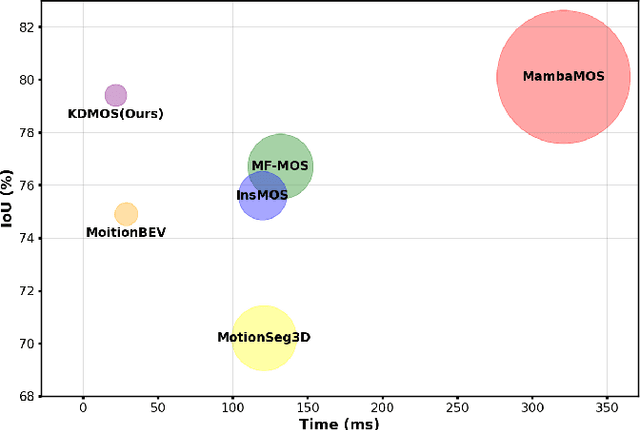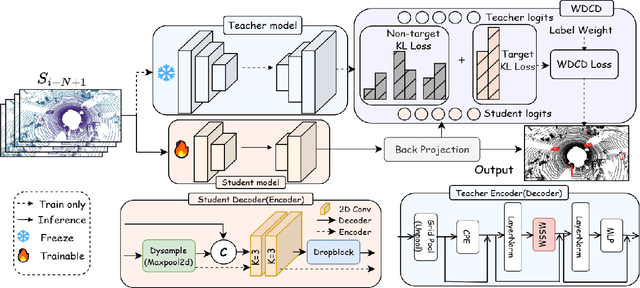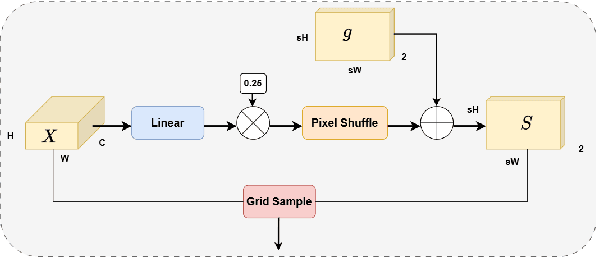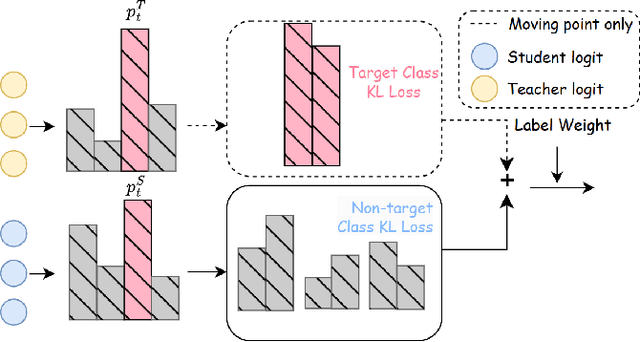Rui Fan
EGTM: Event-guided Efficient Turbulence Mitigation
Sep 04, 2025Abstract:Turbulence mitigation (TM) aims to remove the stochastic distortions and blurs introduced by atmospheric turbulence into frame cameras. Existing state-of-the-art deep-learning TM methods extract turbulence cues from multiple degraded frames to find the so-called "lucky'', not distorted patch, for "lucky fusion''. However, it requires high-capacity network to learn from coarse-grained turbulence dynamics between synchronous frames with limited frame-rate, thus fall short in computational and storage efficiency. Event cameras, with microsecond-level temporal resolution, have the potential to fundamentally address this bottleneck with efficient sparse and asynchronous imaging mechanism. In light of this, we (i) present the fundamental \textbf{``event-lucky insight''} to reveal the correlation between turbulence distortions and inverse spatiotemporal distribution of event streams. Then, build upon this insight, we (ii) propose a novel EGTM framework that extracts pixel-level reliable turbulence-free guidance from the explicit but noisy turbulent events for temporal lucky fusion. Moreover, we (iii) build the first turbulence data acquisition system to contribute the first real-world event-driven TM dataset. Extensive experimental results demonstrate that our approach significantly surpass the existing SOTA TM method by 710 times, 214 times and 224 times in model size, inference latency and model complexity respectively, while achieving the state-of-the-art in restoration quality (+0.94 PSNR and +0.08 SSIM) on our real-world EGTM dataset. This demonstrating the great efficiency merit of introducing event modality into TM task. Demo code and data have been uploaded in supplementary material and will be released once accepted.
A Pseudo Global Fusion Paradigm-Based Cross-View Network for LiDAR-Based Place Recognition
Aug 12, 2025Abstract:LiDAR-based Place Recognition (LPR) remains a critical task in Embodied Artificial Intelligence (AI) and Autonomous Driving, primarily addressing localization challenges in GPS-denied environments and supporting loop closure detection. Existing approaches reduce place recognition to a Euclidean distance-based metric learning task, neglecting the feature space's intrinsic structures and intra-class variances. Such Euclidean-centric formulation inherently limits the model's capacity to capture nonlinear data distributions, leading to suboptimal performance in complex environments and temporal-varying scenarios. To address these challenges, we propose a novel cross-view network based on an innovative fusion paradigm. Our framework introduces a pseudo-global information guidance mechanism that coordinates multi-modal branches to perform feature learning within a unified semantic space. Concurrently, we propose a Manifold Adaptation and Pairwise Variance-Locality Learning Metric that constructs a Symmetric Positive Definite (SPD) matrix to compute Mahalanobis distance, superseding traditional Euclidean distance metrics. This geometric formulation enables the model to accurately characterize intrinsic data distributions and capture complex inter-class dependencies within the feature space. Experimental results demonstrate that the proposed algorithm achieves competitive performance, particularly excelling in complex environmental conditions.
KDMOS:Knowledge Distillation for Motion Segmentation
Jun 17, 2025



Abstract:Motion Object Segmentation (MOS) is crucial for autonomous driving, as it enhances localization, path planning, map construction, scene flow estimation, and future state prediction. While existing methods achieve strong performance, balancing accuracy and real-time inference remains a challenge. To address this, we propose a logits-based knowledge distillation framework for MOS, aiming to improve accuracy while maintaining real-time efficiency. Specifically, we adopt a Bird's Eye View (BEV) projection-based model as the student and a non-projection model as the teacher. To handle the severe imbalance between moving and non-moving classes, we decouple them and apply tailored distillation strategies, allowing the teacher model to better learn key motion-related features. This approach significantly reduces false positives and false negatives. Additionally, we introduce dynamic upsampling, optimize the network architecture, and achieve a 7.69% reduction in parameter count, mitigating overfitting. Our method achieves a notable IoU of 78.8% on the hidden test set of the SemanticKITTI-MOS dataset and delivers competitive results on the Apollo dataset. The KDMOS implementation is available at https://github.com/SCNU-RISLAB/KDMOS.
DepthMatch: Semi-Supervised RGB-D Scene Parsing through Depth-Guided Regularization
May 26, 2025Abstract:RGB-D scene parsing methods effectively capture both semantic and geometric features of the environment, demonstrating great potential under challenging conditions such as extreme weather and low lighting. However, existing RGB-D scene parsing methods predominantly rely on supervised training strategies, which require a large amount of manually annotated pixel-level labels that are both time-consuming and costly. To overcome these limitations, we introduce DepthMatch, a semi-supervised learning framework that is specifically designed for RGB-D scene parsing. To make full use of unlabeled data, we propose complementary patch mix-up augmentation to explore the latent relationships between texture and spatial features in RGB-D image pairs. We also design a lightweight spatial prior injector to replace traditional complex fusion modules, improving the efficiency of heterogeneous feature fusion. Furthermore, we introduce depth-guided boundary loss to enhance the model's boundary prediction capabilities. Experimental results demonstrate that DepthMatch exhibits high applicability in both indoor and outdoor scenes, achieving state-of-the-art results on the NYUv2 dataset and ranking first on the KITTI Semantics benchmark.
A Birotation Solution for Relative Pose Problems
May 04, 2025Abstract:Relative pose estimation, a fundamental computer vision problem, has been extensively studied for decades. Existing methods either estimate and decompose the essential matrix or directly estimate the rotation and translation to obtain the solution. In this article, we break the mold by tackling this traditional problem with a novel birotation solution. We first introduce three basis transformations, each associated with a geometric metric to quantify the distance between the relative pose to be estimated and its corresponding basis transformation. Three energy functions, designed based on these metrics, are then minimized on the Riemannian manifold $\mathrm{SO(3)}$ by iteratively updating the two rotation matrices. The two rotation matrices and the basis transformation corresponding to the minimum energy are ultimately utilized to recover the relative pose. Extensive quantitative and qualitative evaluations across diverse relative pose estimation tasks demonstrate the superior performance of our proposed birotation solution. Source code, demo video, and datasets will be available at \href{https://mias.group/birotation-solution}{mias.group/birotation-solution} upon publication.
MambaFlow: A Novel and Flow-guided State Space Model for Scene Flow Estimation
Feb 24, 2025Abstract:Scene flow estimation aims to predict 3D motion from consecutive point cloud frames, which is of great interest in autonomous driving field. Existing methods face challenges such as insufficient spatio-temporal modeling and inherent loss of fine-grained feature during voxelization. However, the success of Mamba, a representative state space model (SSM) that enables global modeling with linear complexity, provides a promising solution. In this paper, we propose MambaFlow, a novel scene flow estimation network with a mamba-based decoder. It enables deep interaction and coupling of spatio-temporal features using a well-designed backbone. Innovatively, we steer the global attention modeling of voxel-based features with point offset information using an efficient Mamba-based decoder, learning voxel-to-point patterns that are used to devoxelize shared voxel representations into point-wise features. To further enhance the model's generalization capabilities across diverse scenarios, we propose a novel scene-adaptive loss function that automatically adapts to different motion patterns.Extensive experiments on the Argoverse 2 benchmark demonstrate that MambaFlow achieves state-of-the-art performance with real-time inference speed among existing works, enabling accurate flow estimation in real-world urban scenarios. The code is available at https://github.com/SCNU-RISLAB/MambaFlow.
Fully Exploiting Vision Foundation Model's Profound Prior Knowledge for Generalizable RGB-Depth Driving Scene Parsing
Feb 10, 2025



Abstract:Recent vision foundation models (VFMs), typically based on Vision Transformer (ViT), have significantly advanced numerous computer vision tasks. Despite their success in tasks focused solely on RGB images, the potential of VFMs in RGB-depth driving scene parsing remains largely under-explored. In this article, we take one step toward this emerging research area by investigating a feasible technique to fully exploit VFMs for generalizable RGB-depth driving scene parsing. Specifically, we explore the inherent characteristics of RGB and depth data, thereby presenting a Heterogeneous Feature Integration Transformer (HFIT). This network enables the efficient extraction and integration of comprehensive heterogeneous features without re-training ViTs. Relative depth prediction results from VFMs, used as inputs to the HFIT side adapter, overcome the limitations of the dependence on depth maps. Our proposed HFIT demonstrates superior performance compared to all other traditional single-modal and data-fusion scene parsing networks, pre-trained VFMs, and ViT adapters on the Cityscapes and KITTI Semantics datasets. We believe this novel strategy paves the way for future innovations in VFM-based data-fusion techniques for driving scene parsing. Our source code is publicly available at https://mias.group/HFIT.
Environment-Driven Online LiDAR-Camera Extrinsic Calibration
Feb 02, 2025Abstract:LiDAR-camera extrinsic calibration (LCEC) is the core for data fusion in computer vision. Existing methods typically rely on customized calibration targets or fixed scene types, lacking the flexibility to handle variations in sensor data and environmental contexts. This paper introduces EdO-LCEC, the first environment-driven, online calibration approach that achieves human-like adaptability. Inspired by the human perceptual system, EdO-LCEC incorporates a generalizable scene discriminator to actively interpret environmental conditions, creating multiple virtual cameras that capture detailed spatial and textural information. To overcome cross-modal feature matching challenges between LiDAR and camera, we propose dual-path correspondence matching (DPCM), which leverages both structural and textural consistency to achieve reliable 3D-2D correspondences. Our approach formulates the calibration process as a spatial-temporal joint optimization problem, utilizing global constraints from multiple views and scenes to improve accuracy, particularly in sparse or partially overlapping sensor views. Extensive experiments on real-world datasets demonstrate that EdO-LCEC achieves state-of-the-art performance, providing reliable and precise calibration across diverse, challenging environments.
SLC$^2$-SLAM: Semantic-guided Loop Closure with Shared Latent Code for NeRF SLAM
Jan 15, 2025



Abstract:Targeting the notorious cumulative drift errors in NeRF SLAM, we propose a Semantic-guided Loop Closure with Shared Latent Code, dubbed SLC$^2$-SLAM. Especially, we argue that latent codes stored in many NeRF SLAM systems are not fully exploited, as they are only used for better reconstruction. In this paper, we propose a simple yet effective way to detect potential loops using the same latent codes as local features. To further improve the loop detection performance, we use the semantic information, which are also decoded from the same latent codes to guide the aggregation of local features. Finally, with the potential loops detected, we close them with a graph optimization followed by bundle adjustment to refine both the estimated poses and the reconstructed scene. To evaluate the performance of our SLC$^2$-SLAM, we conduct extensive experiments on Replica and ScanNet datasets. Our proposed semantic-guided loop closure significantly outperforms the pre-trained NetVLAD and ORB combined with Bag-of-Words, which are used in all the other NeRF SLAM with loop closure. As a result, our SLC$^2$-SLAM also demonstrated better tracking and reconstruction performance, especially in larger scenes with more loops, like ScanNet.
Establishing Reality-Virtuality Interconnections in Urban Digital Twins for Superior Intelligent Road Inspection
Dec 23, 2024



Abstract:Road inspection is essential for ensuring road maintenance and traffic safety, as road defects gradually emerge and compromise road functionality. Traditional methods, which rely on manual evaluations, are labor-intensive, costly, and time-consuming. Although data-driven approaches are gaining traction, the scarcity and spatial sparsity of road defects in the real world pose significant challenges in acquiring high-quality datasets. Existing simulators designed to generate detailed synthetic driving scenes, however, lack models for road defects. Furthermore, advanced driving tasks involving interactions with road surfaces, such as planning and control in defective areas, remain underexplored. To address these limitations, we propose a system based on Urban Digital Twin (UDT) technology for intelligent road inspection. First, hierarchical road models are constructed from real-world driving data, creating highly detailed representations of road defect structures and surface elevations. Next, digital road twins are generated to create simulation environments for comprehensive analysis and evaluation. These scenarios are subsequently imported into a simulator to enable both data acquisition and physical simulation. Experimental results demonstrate that driving tasks, including perception and decision-making, can be significantly improved using the high-fidelity road defect scenes generated by our system.
 Add to Chrome
Add to Chrome Add to Firefox
Add to Firefox Add to Edge
Add to Edge